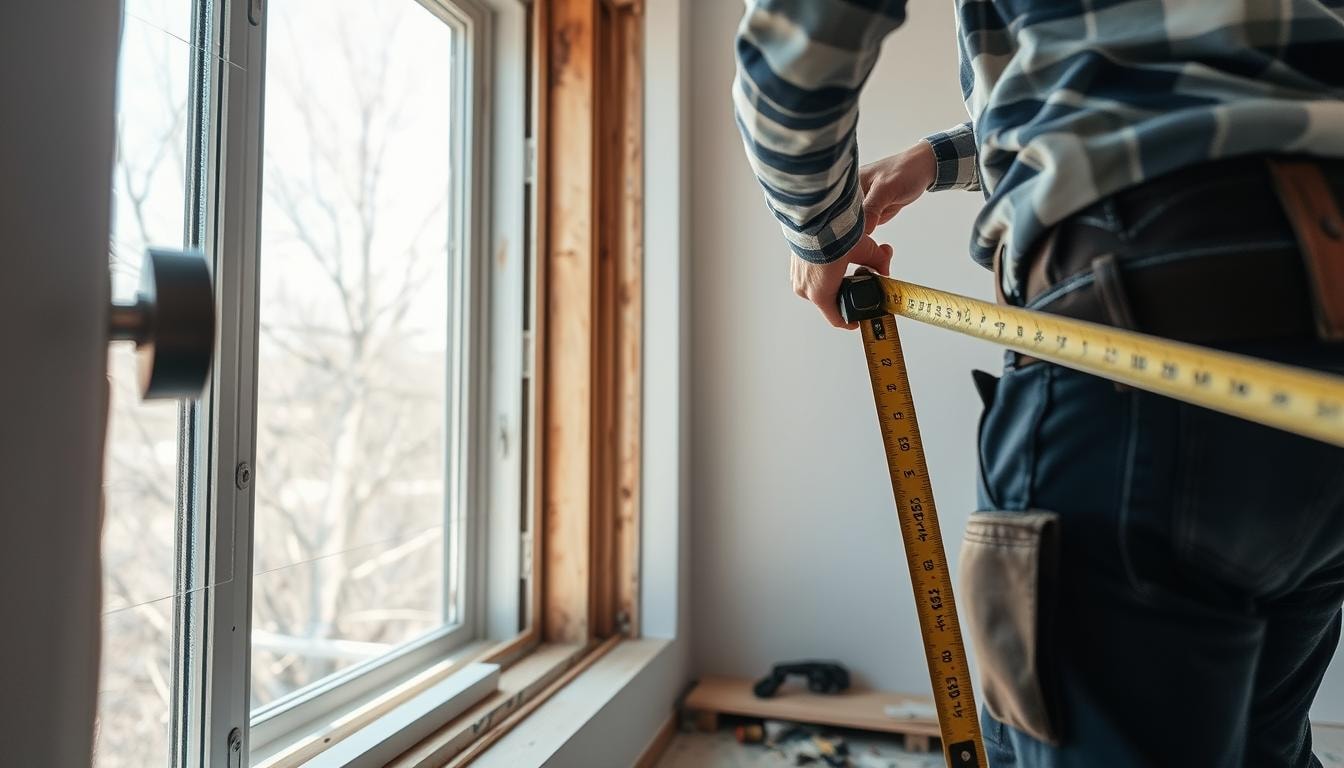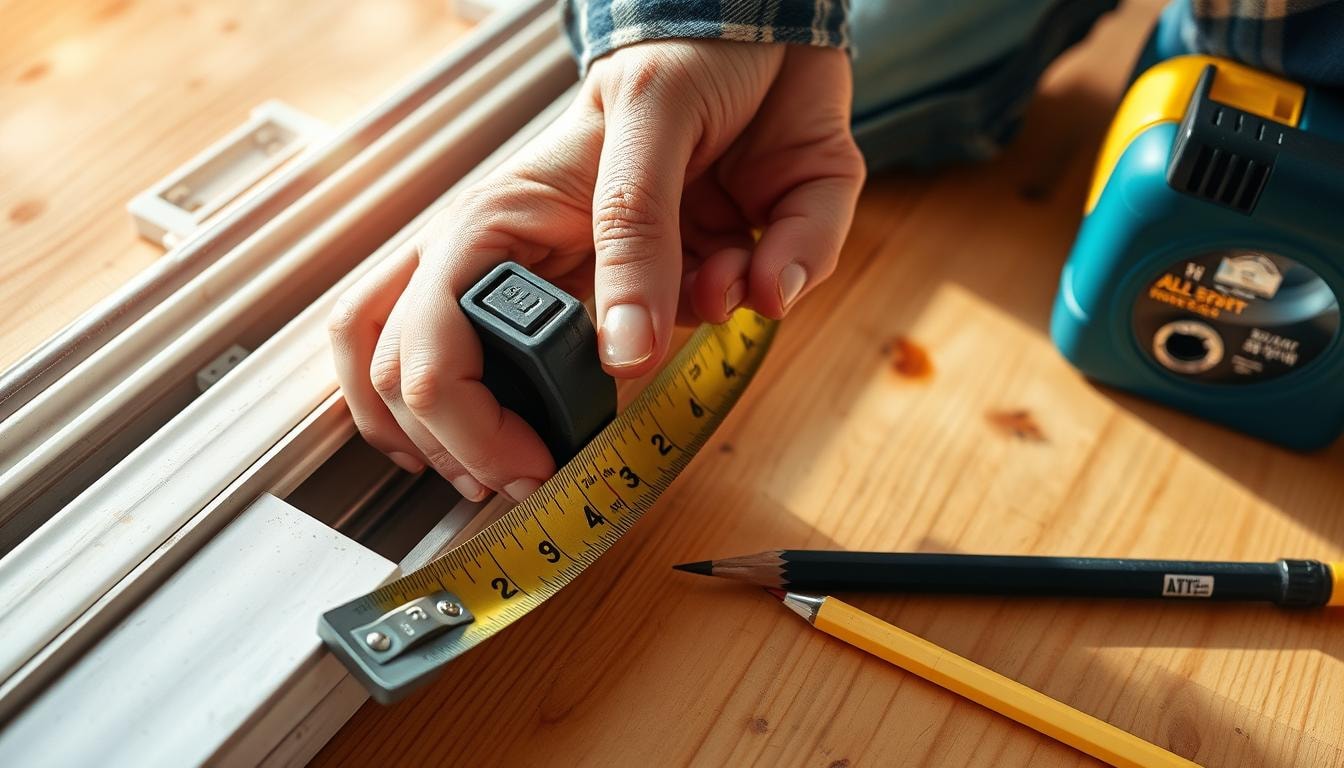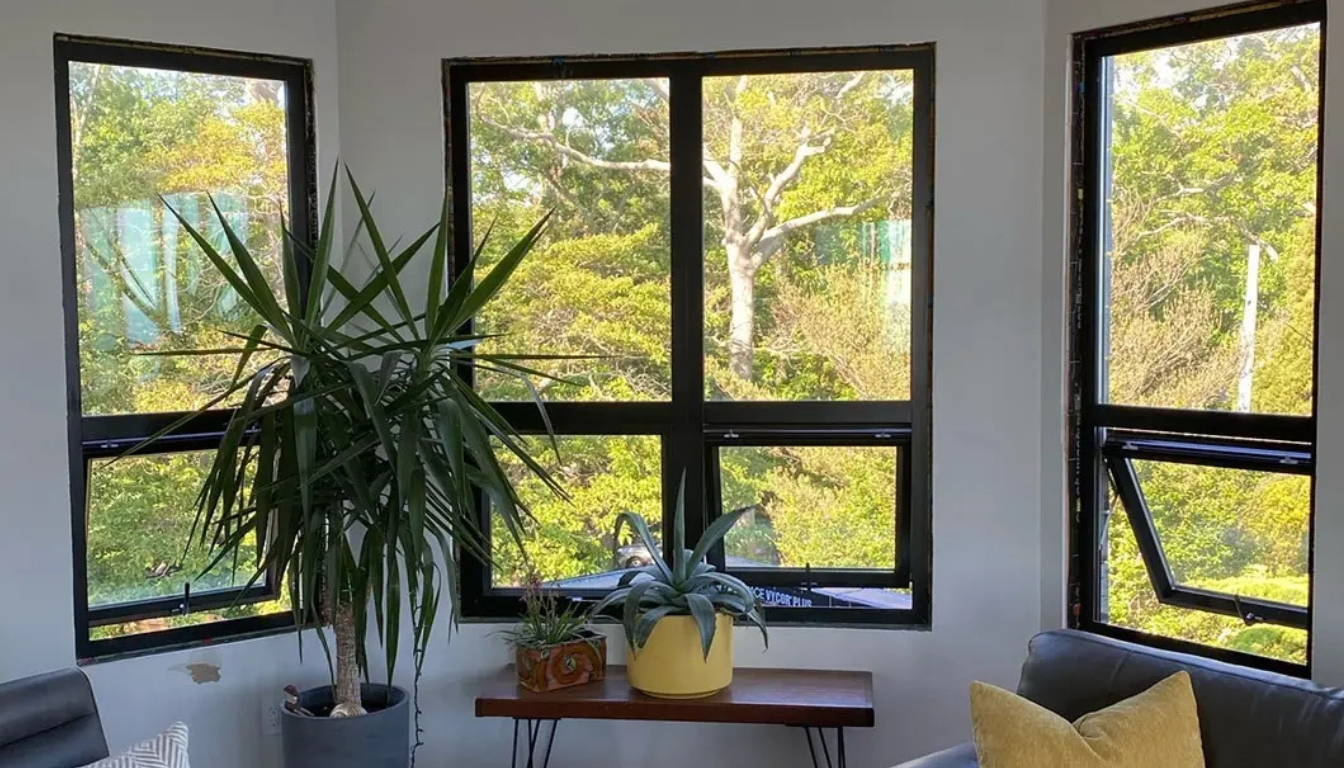
How to Measure Rough Opening for Window Replacement
Getting the right measurements is key for window installation or replacement. It makes sure your windows are energy-efficient and look good. This guide will help you understand the differences in measuring for new windows and replacing old ones.
It also talks about common mistakes people make and why getting a pro to measure is a good idea. Knowing how to measure your windows right is important for any project.
Key Takeaways
- Precise window measurements are critical for a proper, snug fit and energy efficiency.
- Exterior measurements for brick homes are taken from the outside opening, while for other wall types, they’re measured from the window’s outer edge.
- Special situations may require removing the existing frame to accurately measure the rough opening.
- Professional installation offers expertise, the right tools, and a faster project completion time, reducing the risk of mishaps or costly repairs.
- High-quality replacement windows come in various styles and sizes, are energy-efficient, and can save money on heating and cooling costs.
Understanding Window Frame Components
The window frame is key in any window replacement. Knowing its parts is vital for correct measurements and a good install. Let’s look at the main parts of a window frame that everyone should know.
- Head Jamb and Top Edge: The head jamb is the top horizontal part of the window frame. It supports the window and keeps it sealed from air and water. It’s important to measure its width and height right for a good fit.
- Side Jambs and Frame Construction: The side jambs are the vertical parts on each side. They are crucial for the frame’s structure and keeping the window in place. It’s best to measure the side jambs at different points to fit the wall opening well.
- Window Sill and Bottom Components: The window sill is the bottom horizontal part. It looks good and helps keep water out. Measuring its width and depth correctly is key for a smooth fit and to prevent water damage.
Knowing the main parts of a window frame helps homeowners and contractors make smart choices. They can take accurate measurements for a successful window replacement.
What is a Rough Opening and Why it Matters
Understanding the term “rough opening” is key when replacing windows. It’s the framed space in a wall, a bit bigger than the window itself. This extra room is for a tight fit, insulation, and other parts needed for installation.
The window size is usually about half an inch smaller than the rough opening. For example, a 36-inch wide window needs a 36.5-inch wide opening. The same goes for height, with a 48-inch window needing a 48.5-inch tall opening. This extra space ensures the window fits perfectly in the wall.
Getting the rough opening measurements right is vital for a good window replacement. Wrong measurements can cause problems like air leaks, water damage, and structural issues. The size of the opening affects the type of windows you can choose and their style.
Keeping the rough opening in good shape is also important. It helps the window stay in place and work well over time. By knowing how to measure the rough opening correctly, everyone involved can make sure the replacement goes smoothly and lasts long.
Rough Opening vs Actual Window Size Explained
Understanding the difference between the rough opening size and the actual window size is key for a good window replacement. The rough opening is the space where the new window will go. The actual window size is the window’s real dimensions.
Standard Size Differences
The rough opening is usually half an inch bigger than the actual window size. This extra space is for proper installation and adding insulation. For example, a 36×48 inch rough opening can fit a 35.5×47.5 inch window.
Manufacturer Specifications
While a general rule is good, always check the manufacturer’s specs for your window. Different windows need different sizes. The manufacturer’s guidelines will give you the exact measurements for a perfect fit.
Space Allowances for Installation
The space between the rough opening and the actual window size is important. It’s for installing the window right, including shims and insulation. This space makes the window tight and energy-saving, stopping air leaks.
It also lets you adjust the window during installation. This ensures the window works well and meets safety and building codes.
Essential Tools and Materials for Measuring
Starting a window replacement project needs the right tools and materials. You’ll need a good tape measure, level, and notepad to measure the rough opening. Experts use a steel tape measure to get accurate readings. Material tapes can stretch or bend, leading to wrong measurements.
Some contractors also use AI-based apps for even more precise measurements. It’s important to clean and clear the window area before measuring. This helps get accurate measurements for a perfect fit.
- Tape measure (steel preferred over material tape)
- Level
- Notepad for recording measurements
- Optional: AI-powered measurement tools
Make sure the window area is clean and free of obstacles before measuring. This step helps avoid mistakes and makes installation easier. With the right tools and careful planning, you can get the exact measurements for a perfect window fit.
How to Measure Rough Opening for Window Replacement
Getting the right size replacement window is key. Before you start, know the important measurements you need to take.
- Width Measurement Techniques: To measure the width, take three measurements inside the window frame. Do this at the top, middle, and bottom. Use the smallest measurement as the width. This makes sure the new window fits, even if the frame is a bit off.
- Height Measurement Process: Then, measure the height of the opening. Take measurements at the left, center, and right sides. Again, use the smallest figure as the height. Measuring at different points helps with any unevenness in the frame.
- Diagonal Measurements for Square Check: Lastly, measure the diagonals of the window frame. This checks if it’s square. Most replacement windows work if the frame is less than 1/4 inch off. Diagonal measurements can spot big issues with the frame.
By following these width measurement, height measurement, and diagonal measurement steps, you’ll get the perfect replacement window for your home.
Common Measurement Mistakes to Avoid
Getting your windows measured right is key for a good fit and to avoid expensive mistakes. Even skilled homeowners can make common errors. These mistakes can cause big problems later on. Let’s look at some common mistakes and how to avoid them.
One big mistake is only measuring the glass and not the frame. This can make the opening too small. You might need to make changes during installation. Another mistake is measuring from the outside only. This might not give you the right size for a new window.
- Using a flexible tape measure instead of a rigid one can lead to wrong measurements, especially for big openings.
- Forgetting to measure the window depth can cause problems. The new window might not fit right against the wall or stick out too much.
- Not double-checking your measurements can mix up the width and height. This means the new window won’t fit right.
To avoid these mistakes, make sure to double-check your measurements. Use good tools and think about things like handles and window treatments. Getting a pro to measure your windows can also help get it right and make installation easier.

Getting your measurements right is the first step to windows that save energy, make your home more comfortable, and look better. By watching out for common mistakes and taking the right steps, you can have a successful window replacement. And you’ll avoid the costly mistakes of DIY projects.
New Construction vs Replacement Window Measurements
There are big differences between new construction windows and replacement windows. Knowing these differences is key for a good fit and easy installation.
Structural Differences
New construction windows need measurements of the wall’s rough opening. This gives more room for size changes. But, replacement windows must match the size of the current frame and glass. So, they need exact measurements.
Special Considerations
- For replacement windows, measure from inside the frame. This includes any trim or molding.
- New construction windows are put in during framing. This lets you adjust the opening size.
- Replacement windows must fit tightly in the existing frame. So, they need careful measurements and detail.
Getting precise measurements is vital for both new and replacement windows. Knowing the differences helps make your window project a success.
Recording and Verifying Measurements
It’s very important to record and check window measurements right. Start by writing down each measurement on a notepad. Make sure to label them with the window’s location. This way, you can easily find the details when you order new windows.
To make sure your measurements are correct, double-check them. Try to keep measurements within 1/8 inch of each other. This confirms that corners are square. For homes with two stories, use the “sheetrock to sheetrock” method. Add one inch to both horizontal and vertical measurements to account for sheetrock thickness.
- Reduce collected measurements by 1/4 inch to find the correct size of new windows.
- Compare recorded measurements to ensure they are within 1/8 of each other to confirm square corners.
- Measure the rough opening where the window fits, not the frame itself, for the most accurate replacement size.
By focusing on accurate measurements, you’ll avoid costly mistakes or delays. Remember, precise measurements are key to a successful project.
Working with Window Manufacturers and Specifications
When you replace your windows, it’s key to work well with window makers. You need to know their spec sheets and order form needs for a good fit. Many makers use “united inches” – the total of vertical and horizontal sizes – to set prices.
Understanding Spec Sheets
Look over the manufacturer’s spec sheets well. They show you the different parts of a window and their sizes. This helps you pick the right size windows for your space. Remember, windows are usually a bit smaller than the opening to fit right.
Order Form Requirements
- Order windows a bit smaller than your measurements to fit well.
- Know that extra features like different colors or screens cost more.
- Remember, new windows might have thicker frames than old ones. You might need to adjust the inside to fit.
By teaming up with window makers and knowing their specs, you can make the window replacement smoother. This ensures a perfect fit for your needs.

Get Expert Assistance for Your Window Replacement
At Budget Windows, our experienced team is here to guide you through the process of measuring your window rough openings and selecting the perfect replacement windows. Whether you’re dealing with old windows or planning a new double hung window installation, our experts can walk you through the three simple steps to accurately measure the width, height, and diagonals of the rough opening.
We’ll ensure you order the right net frame size that fits snugly, without any gaps along the inside edges or bottom edge. Don’t risk ending up with the wrong size – contact Budget Windows today, and let our professionals handle the measurements and window selection to make your project a success.
Conclusion
Getting the measurements right is key for a good window installation. It ensures the windows fit well, save energy, and look great. You can do it yourself or get help from pros. Either way, knowing how to measure is crucial.
Professional measuring services offer precision and speed. Their experience can make the installation smoother. This means your windows will work well in your home.
Right measurements lead to easy installation and better energy use at home. Measuring the window openings carefully is important. It helps your new windows work better and save money over time.
Learning about window measurement and working with trusted makers and installers is smart. This way, you’ll get the most out of your new windows. Your hard work in measuring accurately will lead to a successful project. Your home will look and work better because of it.
FAQs
What is a window rough opening and why is it important?
The window rough opening is the framed space in the wall that is slightly larger than the window itself. This extra space is crucial for proper installation, insulation, and ensuring a tight, energy-efficient fit for the new window.
How do you measure the window rough opening correctly?
To measure the window rough opening, take the width at the top, middle, and bottom, using the smallest measurement. For the height, measure at the left, center, and right, again using the smallest figure. Also measure the diagonals to check for squareness.
What are some common mistakes to avoid when measuring for window replacement?
Common mistakes include only measuring the glass and not the full frame, using a flexible tape measure instead of a rigid one, and forgetting to measure the depth of the opening. Double-checking all measurements is key to avoid mix-ups.
How do the measurements differ for new construction homes vs. replacing existing windows?
For new construction, you’ll need to measure the rough opening in the wall. But for window replacement, you’ll want to measure the exact size of the existing window frame to ensure a perfect fit.
Why is it a good idea to work with window manufacturers when ordering replacement windows?
Working closely with window manufacturers allows you to understand their specification sheets and order form requirements. This helps you order the right size windows that are slightly smaller than the rough opening for a seamless installation.







